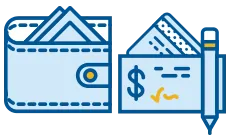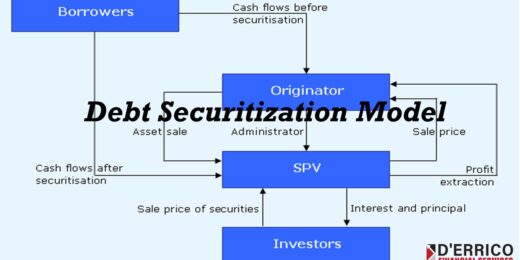The Key Differences Between Levered and Unlevered Free Cash Flow

Understanding cash flow is essential when analyzing a company’s financial health and performance. Two key metrics that provide valuable insights are levered and unlevered free cash flow. These metrics help investors and analysts assess a company’s ability to generate cash from its operations while considering its debt and financial leverage. This blog post will dive deep into levered and unlevered free cash flow dynamics, exploring their definitions, significance, and calculation methods. We will equip you with the knowledge to navigate these crucial financial metrics confidently.
Understanding Levered and Unlevered Free Cash Flow
Suppose you bought a home worth $400,000 under a mortgage loan of $300,000. When friends ask how much your home is, you would say it’s worth $400,000. But in reality, you still have to pay your mortgage monthly, which includes property taxes. To keep it simple, the price you are quoting is the unlevered free cash flow. On the other hand, that price minus the mortgage loan is the levered free cash flow. In other words, the main difference between a levered and unlevered free cash flow is the financial obligation and the impact on income taxes.
The difference between levered and unlevered free cash flow is more than our simple analysis above. Both metrics offer invaluable insights, but using them in the appropriate context is critical to inform sound financial decision-making. The choice depends on the specific financial analysis you are undertaking. Neither levered nor unlevered free cash flow is “better”; each serves a different purpose and is useful in specific contexts.
Unlevered Free Cash Flow
Unlevered free cash flow is also called unleverage free cash flow or free cash flow to firm. It represents the cash generated by a company’s core operating business, without any interest payments and independent of its capital structure (i.e., debt, equity, or a mix of both). In essence, the unlevered free cash flow gauges the ability of a firm to generate cash solely through its operational activities, providing a clearer picture of its innate value and potential for profitability. It offers an undiluted view of a company’s cash generation capability.
When to Use Unlevered Free Cash Flow (UFCF)?
Comparable Company Analysis: Often referred to as “comps,” comparable company analysis evaluates the value of a company by comparing it to similar businesses. In Comparable Company Analysis, the target company is compared to a set of comparable companies based on various financial metrics. Its objective is to determine the valuation multiples for the set of comparable companies and use those multiples to infer a valuation range for the target company. UFCF is particularly useful because it allows for a consistent comparison between companies, irrespective of their capital structure. By stripping out the impact of debt and its associated costs, one can get to the core operating performance of the enterprise. It creates a level playing field for companies in the same industry but with varying debt levels.
Discounted Cash Flow Model: Unlevered Free Cash Flow is often used to ascertain a company’s intrinsic value in a discounted cash flow model or DCIF. When doing a valuation under the DCIF, investors want a clearer picture of a company’s operating performance. The UFCF narrowed the focus to the core operating assets that generate revenue for the business. It ignores the capital structure or interest payment from debt. As such, it makes the valuation more robust and less susceptible to distortions from non-operating assets or activities. While most DCF Models use unlevered Free Cash Flows, DCF Models for banks or insurance companies often will have to focus on the levered cash flows.
Fundraising: Companies often explore different scenarios and financing options when raising funds. Unlevered free cash flow provides a steady ground for investors to evaluate the investment’s merit irrespective of how the fundraising will be structured. UFCF is a pre-financial-obligation metric, meaning it reflects the cash generated by a business before considering debt payments, interest, and taxes. Therefore, it provides a purer representation of a company’s operational efficiency and cash-generating capability. This undistorted view enhances the credibility of a fundraising proposal by giving prospective investors or lenders a clearer picture of the underlying risks and potentials of the business.

Levered Free Cash Flow
Levered free cash flow is also called leveraged free cash flow or free cash flow to equity. It represents the cash available to equity holders after meeting all operational expenses, working capital needs, capital expenditures, and financial obligations such as interest payments. LFCF provides a sophisticated understanding of a company’s financial standing, particularly when considering debt obligations. Levered cash flow is an essential indicator of a company’s ability to meet its debt obligations. A positive levered cash flow signifies that the company generates enough cash to maintain its operations and cover its debt costs, a critical factor for lenders and investors.
When to Use Levered Free Cash Flow (UFCF)?
Equity Valuation: Equity valuation aims to estimate the true value of a company. Levered Cash Flow provides a more accurate representation of the cash available for distribution to equity holders. Therefore, it enables a precise equity valuation by directly tying the value to equity owners’ earnings.
Stocks or Dividends: Levered cash flow is vital for equity investors because it directly affects dividends and capital gains. When a company has strong levered cash flow, it is more likely to distribute dividends or reinvest in growth initiatives that benefit shareholders. Equity investors may use LFCF to evaluate a company’s potential for dividends or stock buybacks. It provides a clear view of the cash actually available to equity holders. For instance, banks and insurance companies often use leverage as a strategic financial tool to enhance their profitability and returns on equity (ROE). Leverage involves using borrowed funds to amplify the potential returns of an investment. Their overall profitability can be higher when they borrow money at a lower cost than the returns they expect to earn on those funds.
Tax Shield: Debt financing often offers a “tax shield,” which is a reduction in taxable income equivalent to the interest payments on the debt. The concept of a tax shield is one of the compelling reasons for companies to include debt in their capital structure. When calculating levered cash flow, the tax shield’s benefits are directly incorporated, allowing for a more accurate representation of the cash flows available to equity holders.

How Do You Calculate Levered and Unlevered Free Cash Flow
Various methodologies to compute the levered and unlevered free cash flows offer a lens through which different aspects of liquidity and operational efficiency can be examined. Let us start with the basics by breaking down free cash flow. Free cash flow represents the cash generated by a business after accounting for operating expenses and capital expenditures. It is the cash left over after the company has paid off its obligations necessary to maintain its current operational structure. This cash can be used for purposes such as reinvestment in the business, acquisition activities, debt repayment, or dividend distribution. Mathematically, a straightforward free cash flow formula is expressed as:
Free Cash Flow = Operating Cash Flow − Capital Expenditures
This formula focuses on the cash generated from operating activities and deducts any capital expenditures required for long-term asset investments.
Unleveraged Free Cash Flow Formula
If the capital structure of a company does not have any debt, the unleveraged free cash flow formula can be mathematically expressed as:
Unleveraged Free Cash Flow (UFCF) = NOPAT + Depreciation and Amortization – Change in Net Working Capital (NWC) – Capital Expenditures
Where:
- NOPAT = Net Operating Profit After Tax. It is the hypothetical operating profit a company would have after taxes if there were no debt in its capital structure. It is the same as EBIT * (1 – company’s Income Tax Rate)
- Depreciation and Amortization (D & A) = The non-cash charges that reduce a company’s income in the income statement but do not impact the cash flow. Since they are accounting measures, adding back depreciation and Amortization to NOPAT ensures that only cash expenses are considered when calculating UFCF.
- Change in Net Working Capital (NWC) = The difference between the current and previous net working capital. Net working capital is the difference between a company’s assets and liabilities.
- Capital Expenditures = The funds a company uses to acquire or upgrade physical assets like property, industrial buildings, or technology. It is considered a cash outflow, a capital investment to improve the business’s future profitability.
As mentioned, the unleveraged free cash flow formula above is hypothetical. In reality, most companies use some form of debt as part of their capital structure to take advantage of the benefits it can provide, such as leverage and tax shields. If we include debt or financing in the scenario, we must replace NOPAT with EBIT×(1−Tax Rate). NOPAT is the firm’s ability to generate returns on capital employed in the business operations post-tax. It is calculated by subtracting the tax component from Earnings Before Interest and Taxes (EBIT). The resulting unleveraged free cash flow formula can be mathematically expressed as:
Unleveraged Free Cash Flow (UFCF) = [EBIT x (1 – Tax Rate)] + Depreciation and Amortization – Change in Net Working Capital (NWC) – Capital Expenditures
How to Get from Unlevered to Levered Cash Flow
It is easy to get a leveraged free cash flow once you have the unleveraged free cash flow formula. All you need to do is add cash flows from debt financing (drawdowns and repayments), subtract the interest payments, and correct for taxes. The total taxes taken into account should reflect the same taxes as expensed on the Income Statement (while the unlevered free cash flows would consider a pro-forma tax typically applied on EBIT).
Here is the formula to calculate leveraged free cash flow (FCF) from unleveraged free cash flows, considering changes in debt, interest payments, pro forma taxes, and interest expenses:
Leveraged Free Cash Flow = Unlevered Free Cash Flows +/- Change in Debt – Interest Payments + Addback Pro Forma Taxes – Interest
Where:
Change in Debt = The net change in the company’s debt during the given period. This change is considered if the company takes on additional debt or pays down existing debt.
Interest Payments = The costs associated with servicing the company’s debt. It includes the interest paid on loans, bonds, and other forms of Debt.
Addback Pro Forma Taxes = The adjusted cash flow to reflect the tax deduction benefit. It can be obtained by adding the tax shield from the interest expenses. This is because interest expenses are tax-deductible, meaning they reduce the company’s taxable income.
Interest = The interest expenses paid by the company during the period.
Sample Calculation
Suppose we have the following assumptions:

Let us now calculate the levered and unlevered free cash flow.

The spreadsheet above shows that the unlevered free cash flow in 2023 is $4,398,865, and the levered free cash flow is $3,307,219. If a company has debt and the interest expenses are significant, just like the assumptions above, its UFCF could be higher than its LFCF. It’s because UFCF doesn’t consider the interest expenses subtracted in the LFCF calculation.
However, there can be instances where LFCF is higher than UFCF, such as when a company has significant tax shields due to interest expenses, leading to lower taxes and potentially boosting the LFCF. Also, if a company has no debt (or very minimal debt), its UFCF and LFCF could be the same because there are no interest expenses to deduct from the net income in the LFCF calculation.
Key Distinctions Between Leveraged and Unleveraged Free Cash Flow
Levered and unlevered cash flow concepts are integral to financial modeling, investment analysis, and valuation. Understanding the key differences between the two is essential since these financial metrics provide invaluable insights into a firm’s financial health and ability to generate value for stakeholders. Below are the key distinctions:
Debt Financing: Unlevered Free Cash Flow (UFCF) represents the cash a business generates before accounting for debt financing costs. It simply shows the cash available to all capital holders— debt and equity —without considering interest payments or tax shields. It excludes debt financing as if the company has no debt. In contrast, levered free cash flow (LFCF) considers the company’s debt financing and interest payments. It accounts for the impact of debt on the company’s cash flow, reflecting the financial obligations to creditors.
Risk Profile: Leveraged free cash flow has a higher risk profile as it considers the company’s debt obligations. If the company cannot generate sufficient levered cash flow, it may be at risk of default. In contrast, unleveraged free cash flow has a lower risk profile as it disregards the impact of debt and provides a pure view of cash generated from operations.
Sensitivity: The sensitivity of levered and unlevered free cash flows also varies significantly. Levered free cash flow is more sensitive to changes in interest rates, capital structure, and debt covenants. Unlevered Cash Flow is less sensitive to external financial conditions since it excludes the cost of debt.
Valuation: Leveraged free cash flow is generally more relevant to equity investors, while unleveraged free cash flow is important for all capital holders, including lenders and investors. LFCF is often used in equity valuation methods like the Dividend Discount Model. The UFCF is commonly used in enterprise valuation models like Discounted Cash Flow (DCF).
View: From the business perspective, UFCF is important because it focuses solely on the company’s core operations without the influence of financing decisions. It provides a clearer picture of their operational efficiency and ability to generate cash. Shareholders are primarily concerned with the returns they receive on their investments, and debt can significantly impact those returns. LFCF accounts for the effects of leverage on the company’s cash flows and provides a more accurate representation of the cash available to equity shareholders.

Levered and Unlevered Free Cash Flow: Invaluable Metrics in Financial Modeling
In the rigorous financial modeling and analysis landscape, levered and unlevered free cash flows are indispensable metrics. These key performance indicators enable a more nuanced understanding of a firm’s financial health, going beyond superficial measures like net profit.
Levered Free Cash Flow accounts for the cost of debt, giving a snapshot of the cash available post-debt service. It is crucial when assessing the sustainability of a firm’s capital structure and the risks associated with its financing mix. On the other hand, unlevered free cash flow provides a pure lens to scrutinize the core operations of a business, decoupled from its financial leverage. It is instrumental for capital budgeting and valuations.
Both metrics provide unparalleled insights into the financial feasibility of investment opportunities and the viability of new projects. These cash flow metrics are not just numerical values but strategic tools that prepare the groundwork for robust financial decision-making. Mastering them is not just an option but a requisite for anyone aiming for financial proficiency and sound strategic maneuvering.
Tags: financial modeling























































































